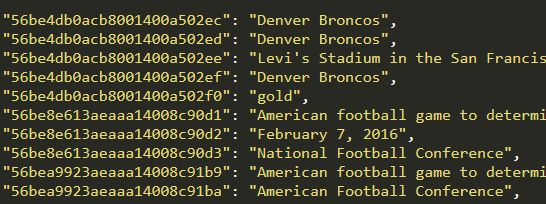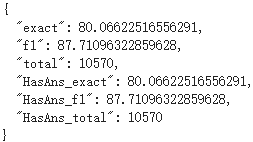本文是《手把手教你用Pytorch-Transformers》的第二篇,主要讲实战
手把手教你用Pytorch-Transformers——部分源码解读及相关说明(一)
使用 PyTorch 的可以结合使用 Apex ,加速训练和减小显存的占用
PyTorch必备神器 | 唯快不破:基于Apex的混合精度加速
github托管地址:https://github.com/NVIDIA/apex
情感分类任务
这里使用 BertForSequenceClassification 进行情感分类任务,还是用 苏剑林 整理的情感二分类数据集
可以结合之前发的那篇一起看,由于官方的 examples 还没细看,这里的例子使用 PyTorch 比较传统的方式进行训练
数据集:
原始Github链接:https://github.com/bojone/bert4keras/tree/master/examples/datasets
个人网盘:链接: https://pan.baidu.com/s/1OAhNbRYpU1HW25_vChdRng 提取码: uxax
用Dataset表示数据集
先放上一些参数设置
# 超参数 hidden_dropout_prob = 0.3 num_labels = 2 learning_rate = 1e-5 weight_decay = 1e-2 epochs = 2 batch_size = 16
继承 PyTorch 的 Dataset ,编写一个类表示数据集,这里我们用字典返回一个样本和它的标签
from torch.utils.data import Dataset import pandas as pd class SentimentDataset(Dataset): def __init__(self, path_to_file): self.dataset = pd.read_csv(path_to_file, sep=" ", names=["text", "label"]) def __len__(self): return len(self.dataset) def __getitem__(self, idx): text = self.dataset.loc[idx, "text"] label = self.dataset.loc[idx, "label"] sample = {"text": text, "label": label} return sample
编写模型
Transformers 已经实现好了用来分类的模型,我们这里就不自己编写了,直接使用 BertForSequenceClassification 调用预训练模型
一些自定义的配置可以通过 BertConfig 传递给 BertForSequenceClassification
from transformers import BertConfig, BertForSequenceClassification # 使用GPU # 通过model.to(device)的方式使用 device = torch.device("cuda:0" if torch.cuda.is_available() else "cpu") config = BertConfig.from_pretrained("bert-base-uncased", num_labels=num_labels, hidden_dropout_prob=hidden_dropout_prob) model = BertForSequenceClassification.from_pretrained("bert-base-uncased", config=config) model.to(device)
想自定义编写模型的话可以参考BertForSequenceClassification。另外,这个BertConfig还可以添加自定义的属性,比如添加一个作者啥的
config = BertConfig.from_pretrained("bert-base-uncased", author="DogeCheng")
读取数据集
用 DataLoader 得到一个迭代器,每次得到一个 batch_size 的数据
from torch.utils.data import DataLoader data_path = "/data/sentiment/" # 加载数据集 sentiment_train_set = SentimentDataset(data_path + "sentiment.train.data") sentiment_train_loader = DataLoader(sentiment_train_set, batch_size=batch_size, shuffle=True, num_workers=2) sentiment_valid_set = SentimentDataset(data_path + "sentiment.train.data") sentiment_valid_loader = DataLoader(sentiment_valid_set, batch_size=batch_size, shuffle=False, num_workers=2)
数据处理
主要实现对文本进行 tokenization 和 padding 的函数
vocab_file = "PyTorch_Pretrained_Model/chinese_wwm_pytorch/vocab.txt" tokenizer = BertTokenizer(vocab_file) def convert_text_to_ids(tokenizer, text, max_len=100): if isinstance(text, str): tokenized_text = tokenizer.encode_plus(text, max_length=max_len, add_special_tokens=True) input_ids = tokenized_text["input_ids"] token_type_ids = tokenized_text["token_type_ids"] elif isinstance(text, list): input_ids = [] token_type_ids = [] for t in text: tokenized_text = tokenizer.encode_plus(t, max_length=max_len, add_special_tokens=True) input_ids.append(tokenized_text["input_ids"]) token_type_ids.append(tokenized_text["token_type_ids"]) else: print("Unexpected input") return input_ids, token_type_ids def seq_padding(tokenizer, X): pad_id = tokenizer.convert_tokens_to_ids("[PAD]") if len(X) <= 1: return torch.tensor(X) L = [len(x) for x in X] ML = max(L) X = torch.Tensor([x + [pad_id] * (ML - len(x)) if len(x) < ML else x for x in X]) return X
定义优化器和损失函数
其实从源码看,我们知道 BertForSequenceClassification 已经有了损失函数,可以不用实现,这里展示一个更通用的例子,自己实现损失函数
import torch import torch.nn as nn from transformers import AdamW # 定义优化器和损失函数 # Prepare optimizer and schedule (linear warmup and decay) no_decay = ['bias', 'LayerNorm.weight'] optimizer_grouped_parameters = [ {'params': [p for n, p in model.named_parameters() if not any(nd in n for nd in no_decay)], 'weight_decay': weight_decay}, {'params': [p for n, p in model.named_parameters() if any(nd in n for nd in no_decay)], 'weight_decay': 0.0} ] #optimizer = AdamW(model.parameters(), lr=learning_rate) optimizer = AdamW(optimizer_grouped_parameters, lr=learning_rate) criterion = nn.CrossEntropyLoss()
从上面我们可以看到 bias 和 LayerNorm.weight 都没用权重衰减,可以参考下面的博文,主要是由于 bias 的更新跟权重衰减无关
权重衰减(weight decay)与学习率衰减(learning rate decay):
https://blog.csdn.net/program_developer/article/details/80867468
定义训练和验证函数
PyTorch 不像 Keras 那样调用 fit 就可以了,大多都需要自己实现,为了复用性,这里用函数实现了简单的训练和测试函数
因为 BertForSequenceClassification 里面已经有了一个 CrossEntropyLoss() ,实际可以不用我们刚刚的实例化的损失函数,见 train() 函数 中的注释
函数返回2个内容:一个 epoch 内的损失和准确率,如果要计算其他评估指标需自己实现(或通过 sklearn.metrics 帮助)
def train(model, iterator, optimizer, criterion, device): model.train() epoch_loss = 0 epoch_acc = 0 for i, batch in enumerate(iterator): label = batch["label"] text = batch["text"] input_ids, token_type_ids = convert_text_to_ids(tokenizer, text) input_ids = seq_padding(tokenizer, input_ids) token_type_ids = seq_padding(tokenizer, token_type_ids) # 标签形状为 (batch_size, 1) label = label.unsqueeze(1) # 需要 LongTensor input_ids, token_type_ids, label = input_ids.long(), token_type_ids.long(), label.long() # 梯度清零 optimizer.zero_grad() # 迁移到GPU input_ids, token_type_ids, label = input_ids.to(device), token_type_ids.to(device), label.to(device) output = model(input_ids=input_ids, token_type_ids=token_type_ids, labels=label) y_pred_prob = output[1] y_pred_label = y_pred_prob.argmax(dim=1) # 计算loss # 这个 loss 和 output[0] 是一样的 loss = criterion(y_pred_prob.view(-1, 2), label.view(-1)) #loss = output[0] # 计算acc acc = ((y_pred_label == label.view(-1)).sum()).item() # 反向传播 loss.backward() optimizer.step() # epoch 中的 loss 和 acc 累加 epoch_loss += loss.item() epoch_acc += acc if i % 200 == 0: print("current loss:", epoch_loss / (i+1), " ", "current acc:", epoch_acc / ((i+1)*len(label))) # return epoch_loss / len(iterator), epoch_acc / (len(iterator) * iterator.batch_size) # 经评论区提醒修改 return epoch_loss / len(iterator), epoch_acc / len(iterator.dataset.dataset) def evaluate(model, iterator, criterion, device): model.eval() epoch_loss = 0 epoch_acc = 0 with torch.no_grad(): for _, batch in enumerate(iterator): label = batch["label"] text = batch["text"] input_ids, token_type_ids = convert_text_to_ids(tokenizer, text) input_ids = seq_padding(tokenizer, input_ids) token_type_ids = seq_padding(tokenizer, token_type_ids) label = label.unsqueeze(1) input_ids, token_type_ids, label = input_ids.long(), token_type_ids.long(), label.long() input_ids, token_type_ids, label = input_ids.to(device), token_type_ids.to(device), label.to(device) output = model(input_ids=input_ids, token_type_ids=token_type_ids, labels=label) y_pred_label = output[1].argmax(dim=1) loss = output[0] acc = ((y_pred_label == label.view(-1)).sum()).item() epoch_loss += loss.item() epoch_acc += acc # return epoch_loss / len(iterator), epoch_acc / (len(iterator) * iterator.batch_size) # 经评论区提醒修改 return epoch_loss / len(iterator), epoch_acc / len(iterator.dataset.dataset)
开始训练
这里只跑了 2 个 epoch,在验证集上的效果达到了 92 的准确率
# 再测试 for i in range(epochs): train_loss, train_acc = train(model, sentiment_train_loader, optimizer, criterion, device) print("train loss: ", train_loss, " ", "train acc:", train_acc) valid_loss, valid_acc = evaluate(model, sentiment_valid_loader, criterion, device) print("valid loss: ", valid_loss, " ", "valid acc:", valid_acc)
第一个 epoch

第二个 epoch

SQuAD任务
官方例子的使用
这里直接使用 Transformers 提供 run_squad.py 进行说明
这里使用的是 SQuAD v1.1 数据集,下载地址为
下载好数据后,放入 $SQUAD_DIR 中,输入以下命令运行
export SQUAD_DIR=/path/to/SQUAD python run_squad.py --model_type bert --model_name_or_path bert-base-cased --do_train --do_eval --do_lower_case --train_file $SQUAD_DIR/train-v1.1.json --predict_file $SQUAD_DIR/dev-v1.1.json --per_gpu_train_batch_size 12 --learning_rate 3e-5 --num_train_epochs 2.0 --max_seq_length 384 --doc_stride 128 --output_dir /tmp/debug_squad/
utils_squad.py
SQuAD数据集是用JSON格式存储的,而且层级很多,下面的链接有SQuAD数据集的结构化展示
我们主要使用到的是 paragraphs 字段的内容,包括context 和 qas
- qas 包括 answers,question 以及 id
- 而 answers 包括 answer_start 和 text
read_squad_examples()
read_squad_examples() 就是负责把原来的JSON数据抽取出来,让数据变得更清晰。每条数据变成一个 SquadExample 对象,存放下面的内容
- qas_id:id
- question_text:question
- doc_tokens:经过 tokenization 后的 text
- orig_answer_text:text
- start_position:开始位置
- end_position:结束位置
- is_impossible:样本是否没有答案
其中 is_impossible 是SQuAD v2才有的字段,read_squad_examples() 会判断数据集的版本,我们在运行 run_squad.py时,可以通过 --version_2_with_negative 参数设置
if version_2_with_negative: is_impossible = qa["is_impossible"]
数据集只提供了 answer_start,所以 end_position 需要自己计算,即 start_position 加上答案的长度-1
if not is_impossible: answer = qa["answers"][0] orig_answer_text = answer["text"] answer_offset = answer["answer_start"] answer_length = len(orig_answer_text) start_position = char_to_word_offset[answer_offset] end_position = char_to_word_offset[answer_offset + answer_length - 1]
convert_examples_to_features()
read_squad_examples() 负责从 JSON 中读取数据,并进行一些处理,但是这样不能输入 Bert 模型中
所以还需要使用 convert_examples_to_features() 函数处理成能够输入到 Bert 中的格式,主要是截断、padding 和 token转换为id等
如简单粗暴的截断操作
if len(query_tokens) > max_query_length: query_tokens = query_tokens[0:max_query_length]
token 转换成 id 和 mask 等操作
input_ids = tokenizer.convert_tokens_to_ids(tokens) # The mask has 1 for real tokens and 0 for padding tokens. Only real # tokens are attended to. input_mask = [1 if mask_padding_with_zero else 0] * len(input_ids)
padding 操作
# Zero-pad up to the sequence length. while len(input_ids) < max_seq_length: input_ids.append(pad_token) input_mask.append(0 if mask_padding_with_zero else 1) segment_ids.append(pad_token_segment_id) p_mask.append(1)
最后每个样本用 InputFeatures 对象存放这些处理后的数据
run_squad.py
run_squad.py 用一个字典存放不同模型用到的Config、Model 和 Tokenizer,通过 --model_type 参数使用
MODEL_CLASSES = { 'bert': (BertConfig, BertForQuestionAnswering, BertTokenizer), 'xlnet': (XLNetConfig, XLNetForQuestionAnswering, XLNetTokenizer), 'xlm': (XLMConfig, XLMForQuestionAnswering, XLMTokenizer), 'distilbert': (DistilBertConfig, DistilBertForQuestionAnswering, DistilBertTokenizer), 'albert': (AlbertConfig, AlbertForQuestionAnswering, AlbertTokenizer) }
我们通过 --model_type 参数使用需要的模型,并在 main() 函数中实例化 config、model 和 tokenizer 对象
config_class, model_class, tokenizer_class = MODEL_CLASSES[args.model_type]
准备数据集
使用 read_squad_examples 处理再用 convert_examples_to_features 将每一个样本用 InputFeatures 对象表示
再通过 load_and_cache_examples() 将数据全部变成张量,大致代码如下
...
examples = read_squad_examples(input_file=input_file, is_training=not evaluate, version_2_with_negative=args.version_2_with_negative) features = convert_examples_to_features(examples=examples, tokenizer=tokenizer, max_seq_length=args.max_seq_length, doc_stride=args.doc_stride, max_query_length=args.max_query_length, is_training=not evaluate, cls_token_segment_id=2 if args.model_type in ['xlnet'] else 0, pad_token_segment_id=3 if args.model_type in ['xlnet'] else 0, cls_token_at_end=True if args.model_type in ['xlnet'] else False, sequence_a_is_doc=True if args.model_type in ['xlnet'] else False) ... # Convert to Tensors and build dataset all_input_ids = torch.tensor([f.input_ids for f in features], dtype=torch.long) all_input_mask = torch.tensor([f.input_mask for f in features], dtype=torch.long) all_segment_ids = torch.tensor([f.segment_ids for f in features], dtype=torch.long) all_cls_index = torch.tensor([f.cls_index for f in features], dtype=torch.long) all_p_mask = torch.tensor([f.p_mask for f in features], dtype=torch.float) if evaluate: all_example_index = torch.arange(all_input_ids.size(0), dtype=torch.long) dataset = TensorDataset(all_input_ids, all_input_mask, all_segment_ids, all_example_index, all_cls_index, all_p_mask) else: all_start_positions = torch.tensor([f.start_position for f in features], dtype=torch.long) all_end_positions = torch.tensor([f.end_position for f in features], dtype=torch.long) dataset = TensorDataset(all_input_ids, all_input_mask, all_segment_ids, all_start_positions, all_end_positions, all_cls_index, all_p_mask) if output_examples: return dataset, examples, features return dataset
在 main() 函数中将这些数据变成张量后,再送到 train() 函数中
train_dataset = load_and_cache_examples(args, tokenizer, evaluate=False, output_examples=False)
global_step, tr_loss = train(args, train_dataset, model, tokenizer)
train()
这里也使用 DataLoader 将数据集变成生成器,用来取出一个 batch 的数据训练
train_sampler = RandomSampler(train_dataset) if args.local_rank == -1 else DistributedSampler(train_dataset) train_dataloader = DataLoader(train_dataset, sampler=train_sampler, batch_size=args.train_batch_size)
定义优化器
no_decay = ['bias', 'LayerNorm.weight'] optimizer_grouped_parameters = [ {'params': [p for n, p in model.named_parameters() if not any(nd in n for nd in no_decay)], 'weight_decay': args.weight_decay}, {'params': [p for n, p in model.named_parameters() if any(nd in n for nd in no_decay)], 'weight_decay': 0.0} ] optimizer = AdamW(optimizer_grouped_parameters, lr=args.learning_rate, eps=args.adam_epsilon)
还使用了学习率预热,训练时先从小的学习率开始训练
scheduler = get_linear_schedule_with_warmup(optimizer, num_warmup_steps=args.warmup_steps, num_training_steps=t_total)
如果机器上有 apex ,可以通过 --fp16 参数设置,进行加速训练
if args.fp16: try: from apex import amp except ImportError: raise ImportError("Please install apex from https://www.github.com/nvidia/apex to use fp16 training.") model, optimizer = amp.initialize(model, optimizer, opt_level=args.fp16_opt_level)
训练过程设置了 checkpoint,默认每 50 个 step 保存一次模型,可以通过 --save_steps 修改
if args.local_rank in [-1, 0] and args.save_steps > 0 and global_step % args.save_steps == 0: # Save model checkpoint output_dir = os.path.join(args.output_dir, 'checkpoint-{}'.format(global_step)) if not os.path.exists(output_dir): os.makedirs(output_dir) model_to_save = model.module if hasattr(model, 'module') else model # Take care of distributed/parallel training model_to_save.save_pretrained(output_dir) torch.save(args, os.path.join(output_dir, 'training_args.bin')) logger.info("Saving model checkpoint to %s", output_dir)
在 BertForQuestionAnswering 中,它会把 sequence_output 送到一个全连接层中,转换 hidden_size 维度为2,然后split输出,得到 start_logits 和 end_logits
下面是 BertForQuestionAnswering 中的代码片段,描述了上面说的过程
logits = self.qa_outputs(sequence_output)
start_logits, end_logits = logits.split(1, dim=-1)
start_logits 和 end_logits 就是每个 Bert 预测答案开始和结束位置的置信度,这个过程大致如下图所示

BertForQuestionAnswering 计算损失的方式就是 start_logits 和 end_logits 分别计算 loss 再相加取平均
loss_fct = CrossEntropyLoss(ignore_index=ignored_index) start_loss = loss_fct(start_logits, start_positions) end_loss = loss_fct(end_logits, end_positions) total_loss = (start_loss + end_loss) / 2
evaluate()
如果设置了 --do_eval 参数,模型训练完后会进行测试
预测完成后生成的文件有 predictions_.json 和 nbest_predictions_.json 等
其中 predictions_.json 记录的是每个问题 id 对应的最佳答案,如下图所示

nbest_predictions_.json 记录的是每个问题 id 对应的 n 个最佳答案

这是我跑的结果
